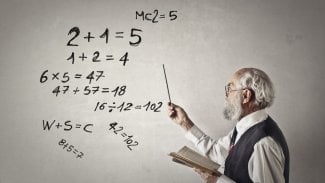cgeesx
NAME
CGEESX - compute for an N-by-N complex nonsymmetric matrix A, the eigenvalues, the Schur form T, and, optionally, the matrix of Schur vectors Z
SYNOPSIS
SUBROUTINE CGEESX(
JOBVS, SORT, SELECT, SENSE, N, A, LDA, SDIM, W,
VS, LDVS, RCONDE, RCONDV, WORK, LWORK, RWORK,
BWORK, INFO )
CHARACTER
JOBVS, SENSE, SORT
INTEGER
INFO, LDA, LDVS, LWORK, N, SDIM
REAL
RCONDE, RCONDV
LOGICAL
BWORK( * )
REAL
RWORK( * )
COMPLEX
A( LDA, * ), VS( LDVS, * ), W( * ), WORK( * )
LOGICAL
SELECT
EXTERNAL
SELECT
PURPOSE
CGEESX computes for an N-by-N complex nonsymmetric matrix A, the eigenvalues, the Schur form T, and, optionally, the matrix of Schur vectors Z. This gives the Schur factorization A = Z*T*(Z**H).
Optionally, it also orders the eigenvalues on the diagonal of the
Schur form so that selected eigenvalues are at the top left;
computes a reciprocal condition number for the average of the
selected eigenvalues (RCONDE); and computes a reciprocal condition
number for the right invariant subspace corresponding to the
selected eigenvalues (RCONDV). The leading columns of Z form an
orthonormal basis for this invariant subspace.
For further explanation of the reciprocal condition numbers RCONDE and RCONDV, see Section 4.10 of the LAPACK Users' Guide (where these quantities are called s and sep respectively).
A complex matrix is in Schur form if it is upper triangular.
For further explanation of the reciprocal condition numbers RCONDE and RCONDV, see Section 4.10 of the LAPACK Users' Guide (where these quantities are called s and sep respectively).
A complex matrix is in Schur form if it is upper triangular.
ARGUMENTS
JOBVS (input) CHARACTER*1
= 'N': Schur vectors are not computed;
= 'V': Schur vectors are computed.
= 'V': Schur vectors are computed.
SORT (input) CHARACTER*1
Specifies whether or not to order the eigenvalues on the
diagonal of the Schur form.
= 'N': Eigenvalues are not ordered;
= 'S': Eigenvalues are ordered (see SELECT).
= 'S': Eigenvalues are ordered (see SELECT).
SELECT (input) LOGICAL FUNCTION of one COMPLEX argument
SELECT must be declared EXTERNAL in the calling subroutine.
If SORT = 'S', SELECT is used to select eigenvalues to order
to the top left of the Schur form.
If SORT = 'N', SELECT is not referenced.
An eigenvalue W(j) is selected if SELECT(W(j)) is true.
SENSE (input) CHARACTER*1
Determines which reciprocal condition numbers are computed.
= 'N': None are computed;
= 'E': Computed for average of selected eigenvalues only;
= 'V': Computed for selected right invariant subspace only;
= 'B': Computed for both. If SENSE = 'E', 'V' or 'B', SORT must equal 'S'.
= 'E': Computed for average of selected eigenvalues only;
= 'V': Computed for selected right invariant subspace only;
= 'B': Computed for both. If SENSE = 'E', 'V' or 'B', SORT must equal 'S'.
N (input) INTEGER
The order of the matrix A. N >= 0.
A (input/output) COMPLEX array, dimension (LDA, N)
On entry, the N-by-N matrix A.
On exit, A is overwritten by its Schur form T.
LDA (input) INTEGER
The leading dimension of the array A. LDA >= max(1,N).
SDIM (output) INTEGER
If SORT = 'N', SDIM = 0.
If SORT = 'S', SDIM = number of eigenvalues for which
SELECT is true.
W (output) COMPLEX array, dimension (N)
W contains the computed eigenvalues, in the same order
that they appear on the diagonal of the output Schur form T.
VS (output) COMPLEX array, dimension (LDVS,N)
If JOBVS = 'V', VS contains the unitary matrix Z of Schur
vectors.
If JOBVS = 'N', VS is not referenced.
LDVS (input) INTEGER
The leading dimension of the array VS. LDVS >= 1, and if
JOBVS = 'V', LDVS >= N.
RCONDE (output) REAL
If SENSE = 'E' or 'B', RCONDE contains the reciprocal
condition number for the average of the selected eigenvalues.
Not referenced if SENSE = 'N' or 'V'.
RCONDV (output) REAL
If SENSE = 'V' or 'B', RCONDV contains the reciprocal
condition number for the selected right invariant subspace.
Not referenced if SENSE = 'N' or 'E'.
WORK (workspace/output) COMPLEX array, dimension (LWORK)
On exit, if INFO = 0, WORK(1) returns the optimal LWORK.
LWORK (input) INTEGER
The dimension of the array WORK. LWORK >= max(1,2*N).
Also, if SENSE = 'E' or 'V' or 'B', LWORK >= 2*SDIM*(N-SDIM),
where SDIM is the number of selected eigenvalues computed by
this routine. Note that 2*SDIM*(N-SDIM) <= N*N/2.
For good performance, LWORK must generally be larger.
RWORK (workspace) REAL array, dimension (N)
BWORK (workspace) LOGICAL array, dimension (N)
Not referenced if SORT = 'N'.
INFO (output) INTEGER
= 0: successful exit
< 0: if INFO = -i, the i-th argument had an illegal value.
> 0: if INFO = i, and i is
<= N: the QR algorithm failed to compute all the
eigenvalues; elements 1:ILO-1 and i+1:N of W contain those eigenvalues which have converged; if JOBVS = 'V', VS contains the transformation which reduces A to its partially converged Schur form. = N+1: the eigenvalues could not be reordered because some eigenvalues were too close to separate (the problem is very ill-conditioned); = N+2: after reordering, roundoff changed values of some complex eigenvalues so that leading eigenvalues in the Schur form no longer satisfy SELECT=.TRUE. This could also be caused by underflow due to scaling.
< 0: if INFO = -i, the i-th argument had an illegal value.
> 0: if INFO = i, and i is
<= N: the QR algorithm failed to compute all the
eigenvalues; elements 1:ILO-1 and i+1:N of W contain those eigenvalues which have converged; if JOBVS = 'V', VS contains the transformation which reduces A to its partially converged Schur form. = N+1: the eigenvalues could not be reordered because some eigenvalues were too close to separate (the problem is very ill-conditioned); = N+2: after reordering, roundoff changed values of some complex eigenvalues so that leading eigenvalues in the Schur form no longer satisfy SELECT=.TRUE. This could also be caused by underflow due to scaling.



















